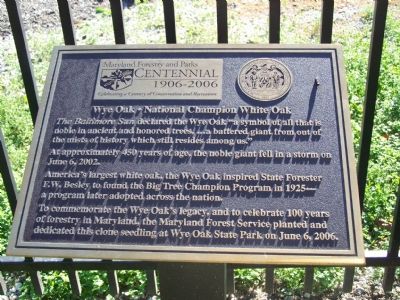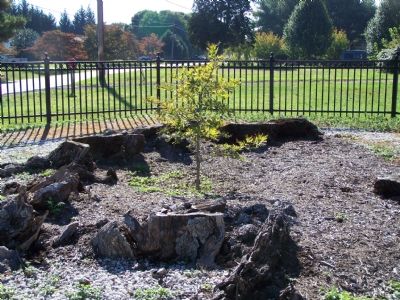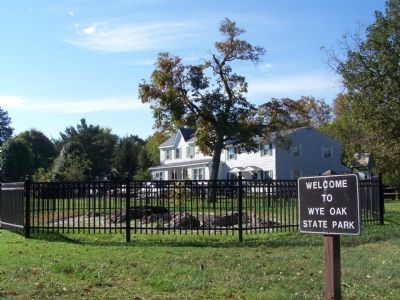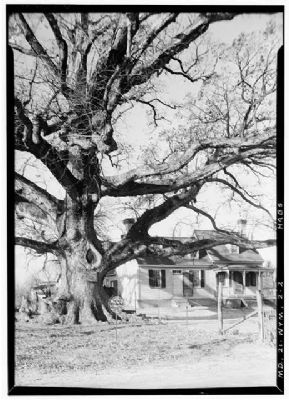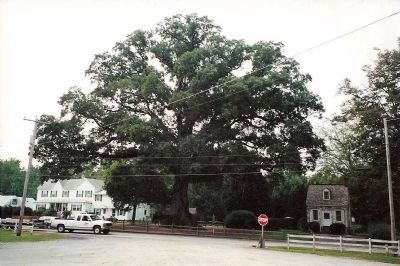Wye Mills in Talbot County, Maryland — The American Northeast (Mid-Atlantic)
Wye Oak
National Champion White Oak
The Baltimore Sun declared the Wye Oak “a symbol of all that is noble in ancient and honored trees, ...a battered giant from out of the mists of history which still resides among us.”
At approximately 450 years of age, the noble giant fell in a storm on June 6, 2002.
America’s largest white oak, the Wye Oak inspired State Forester F. W. Besley to found the Big Tree Champion Program in 1925—a program later adopted across the nation.
To commemorate the Wye Oak’s legacy, and to celebrate 100 years of forestry in Maryland, the Maryland Forest Service planted and dedicated this clone seedling at Wye Oak State Park on June 6, 2006.
Erected by Maryland Forestry and Parks.
Topics. This historical marker is listed in these topic lists: Colonial Era • Horticulture & Forestry • Landmarks. A significant historical month for this entry is June 1777.
Location. 38° 56.363′ N, 76° 4.835′ W. Marker is in Wye Mills, Maryland, in Talbot County. Marker is on Maryland Route 662, 0.3 miles south of Maryland Route 213, on the right when traveling south. Touch for map. Marker is in this post office area: Wye Mills MD 21679, United States of America. Touch for directions.
Other nearby markers. At least 8 other markers are within walking distance of this marker. Preserving a Legacy (here, next to this marker); Wye Oak House (here, next to this marker); The “Little House” in the Shade (a few steps from this marker); a different marker also named The Wye Oak (a few steps from this marker); A Glimpse Inside a Giant (within shouting distance of this marker); Wye Grist Mill (approx. 0.2 miles away); A Brief History of the Mill (approx. 0.2 miles away); So, How Does a Mill Work? (approx. 0.2 miles away). Touch for a list and map of all markers in Wye Mills.
Also see . . .
1. The Quiet Giant, The Wye Oak. Maryland Department of Natural Resources website entry (Submitted on July 27, 2022, by Larry Gertner of New York, New York.)
2. Maryland at a Glance - State Tree. “Decidedly uncommon was the magnificant specimen of White Oak known as the Wye Oak.” (Submitted on November 2, 2007, by Kevin W. of Stafford, Virginia.)
3. HABS/HAER information about the Wye Oak. Library of Congress website entry (Submitted on November 2, 2007, by Kevin W. of Stafford, Virginia.)
4. Mourning a champ: Maryland's Wye Oak. The Free Library website entry:
An article by Charles Enloe, published in American Forests, Summer, 2002. (Submitted on November 2, 2007, by Kevin W. of Stafford, Virginia.)
5. The Wye Oak gets a desk job. The Free Library website entry:
The felled 450-year old oak tree became a desk in Maryland's governor's mansion. An article published in American
Forests, summer 2003 (Submitted on November 2, 2007, by Kevin W. of Stafford, Virginia.)
Additional commentary.
1. Maryland's Official State Tree
Located in the village of Wye in Talbot County, the State tree is the White Oak or the Wye Oak. While King Henry VIII ruled England (1509–1547) a white oak acorn sprouted in the earth of the Atlantic seaboard on the newly discovered continent of North America. The little seedling took root on a peninsula called “Chesopieoc” by the Indians. By the time Lord Baltimore’s English settlers came and proclaimed the colony Maryland (1634) our oak was a magnificent, mature tree. Plantations sprang up along the Wye River site in the 1660’s and a mill was established at the site. By the time the United States had successfully survived the Revolution and Maryland had ratified the U.S. Constitution (1788) the Wye Oak still lived and continued to live and survive the second war with England and leaf out every spring through the Civil War. Today, what remains of the oak is a part of the Wye Oak State Park. State foresters and the Maryland Arborists’ Association cared for the Wye Oak which, prior to June, 2002 was still in a state of remarkably good health. Its height was ninety-five feet, with a horizontal spread of one hundred sixty-five feet. The trunk was more than twenty-one feet in circumference, and its age was estimated to be more than four hundred sixty years old. This beloved tree was purchased by the State of Maryland in 1939, and because of its inspiring tenacity and impressive size the State of Maryland designated the Wye Oak the official tree of Maryland in 1941. When the State of Maryland purchased the tree, it was the first time in America that a governmental agency purchased a single tree.
This wonderful symbol, the Wye Oak, Maryland’s State Tree and the largest White Oak in the United States, and older than the State itself, sadly toppled June 6, 2002 during a thunderstorm. What remains today is its massive stump, encased in honorary wrought iron.
- John T. Marck, www.marylandtheseventhstate.com
— Submitted November 2, 2007, by Kevin W. of Stafford, Virginia.
Credits. This page was last revised on September 14, 2022. It was originally submitted on October 26, 2007, by Bill Pfingsten of Bel Air, Maryland. This page has been viewed 3,987 times since then and 26 times this year. Photos: 1, 2, 3. submitted on October 26, 2007, by Bill Pfingsten of Bel Air, Maryland. 4. submitted on November 2, 2007, by Kevin W. of Stafford, Virginia. 5. submitted on May 9, 2010, by F. Robby of Baltimore, Maryland. • Kevin W. was the editor who published this page.
